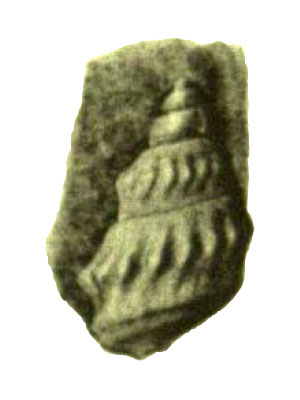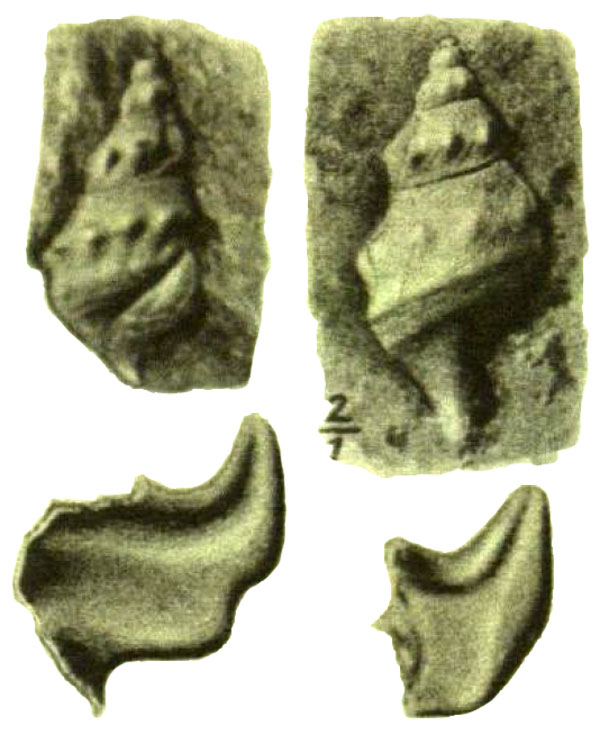Species / Struthioptera Novoseelandica
Stromboidea
Original description of Perissoptera novo-seelandica by Wilckens, 1922, p. 13:
- "The rather small shell consists of about 6 whorls. The initial whorls are lost in all specimens. The spire is narrow-conical. The oldest whorls bear no sculpture. It is impossible to state if here the uppermost layer of the shell has been worn away or if these whorls were simply rounded. It is only in the middle of the penultimate whorl that a node-ridge appears which becomes quite distinct only on the last whorl. The nodes have a direction a little oblique to the axis of the shell. Above the node-ridge the whorl is declivous, below it has a vertical slope. The suture is not impressed. The nodes reach to the beginning of the wing, but there they become obsolete. Besides the nodes there exists a fine spiral sculpture. The growth-lines are faint; on the shoulder of the whorls they recurve down to the keel, below this they are bent forward. The body-whorl bears a second ridge below the nodes, forming a second keel a little noded; a third and smooth one follows below it, and from this downward the growth-lines recurve. The third keel is very slight in some specimens; in others it is more marked, and even followed by a fourth. The inner lip spreads over the parietal wall and forms a very thick callosity. The outer lip is enlarged, and is attached to the penultimate whorl up to its node-ridge. In the prolongation of the chief keel the outer lip forms a broad digit, the top of which reaches almost as high as the suture between the penultimate and the antepenultimate whorl. The lower part of the outer lip, lying in the prolongation of the second keel, forms a rounded projection, separated from the digit by a deeper or shallower sinus. Sometimes this projection is only slightly indicated. The short channel of the shell is separated from the lower lobe of the wing by a shallow sinus. The sculpture of the external surface of the wing is imperceptible; it seems to have spiral striae. The inside of the wing shows furrows corresponding to the keels of the outside; the uppermost furrow continues up to the top of the digit. The casts show whorls a little flattened at the sutures, and two keels on the body-whorl, a noded one above and a smooth rounded one below."
Locus typicus: Amuri Group, West Wing Amuri Bluff, Kaikoura County, Marlborough, South Island, New Zealand
Stratum typicum: Okarahia Sandstone?, Piripauan Stage, Santonian–Campanian, Cretaceous
Lectotype: O. Wilckens, 1922 pl. 2 fig. 10, designated by Stilwell, 2003, p. 325, no. TM 2623 (Institute of Geological and Nuclear Sciences, Lower Hutt, New Zealand)
Perissoptera novo-seelandica Wilckens, 1922, pl. II, fig. 10
Perissoptera novo-seelandica Wilckens, 1922, pl. II, fig. 11, 12, 13, 14
References
- Finlay & Marwick, 1937
- Stilwell, J.D. 1998. Late Cretaceous Mollusca from the Chatham Islands, New Zealand. Alcheringa, 22(1/2): 29-85
- Stilwell, 2003
- Warren, G.; Speden, I.G. 1978 The Piripauan and Haumurian stratotypes (Mata Series, Upper Cretaceous) and correlative sequences in the Haumuri Bluff district, south Marlborough (S56). New Zealand Geological Survey bulletin 92
- Wilckens, 1922


